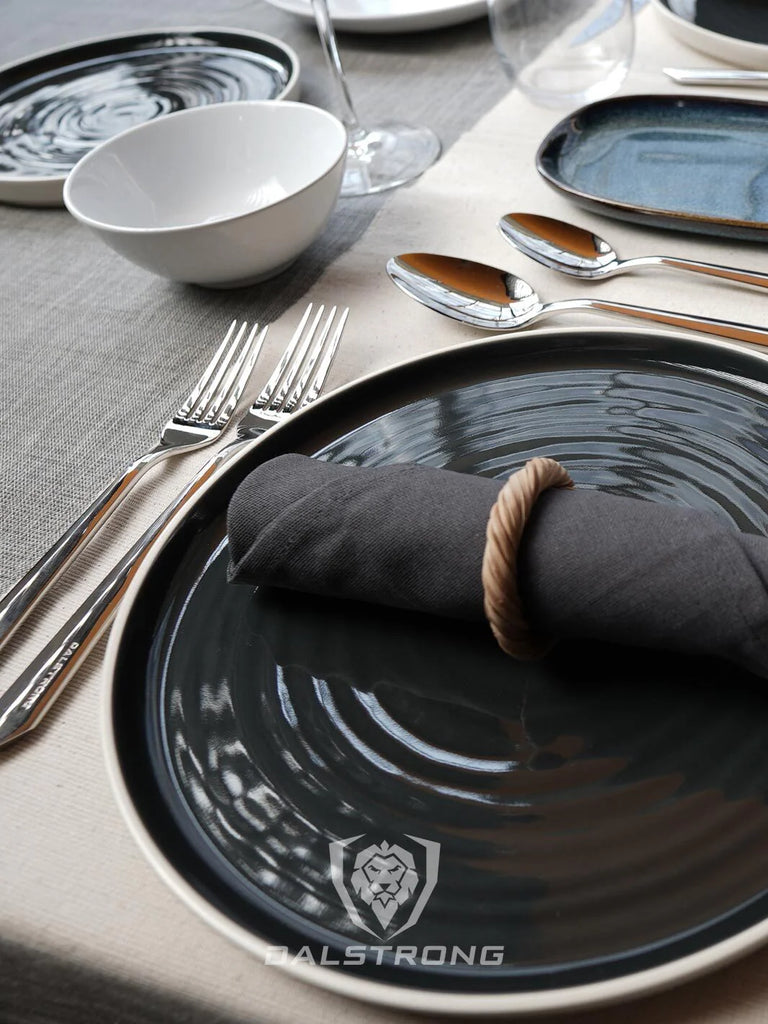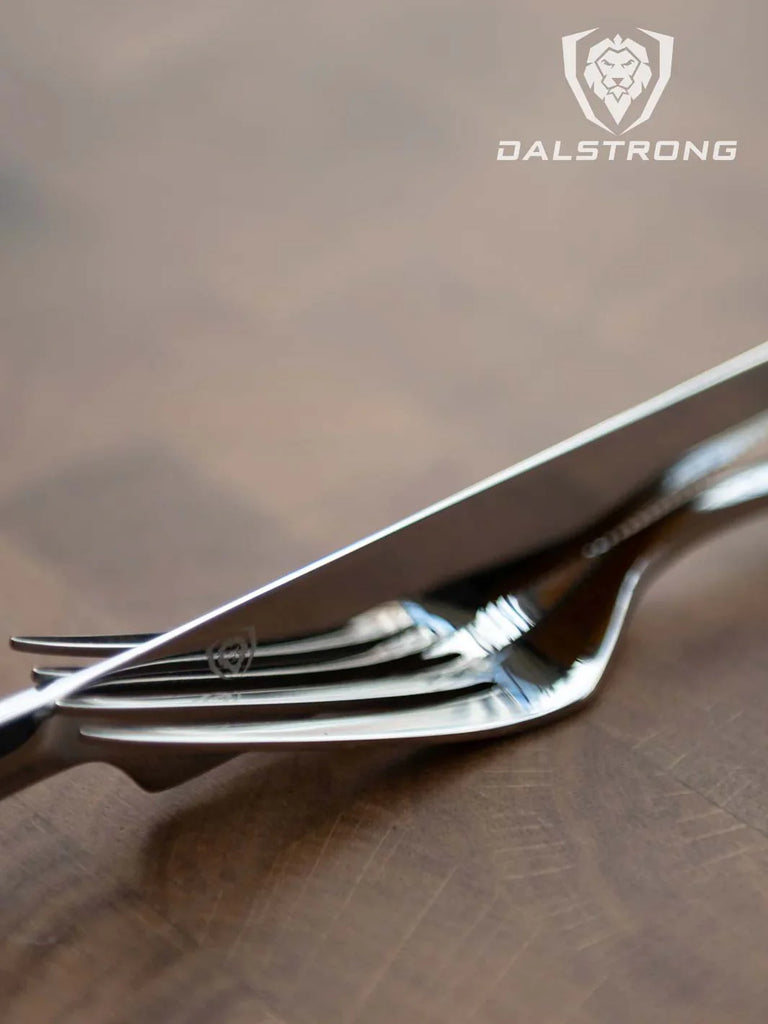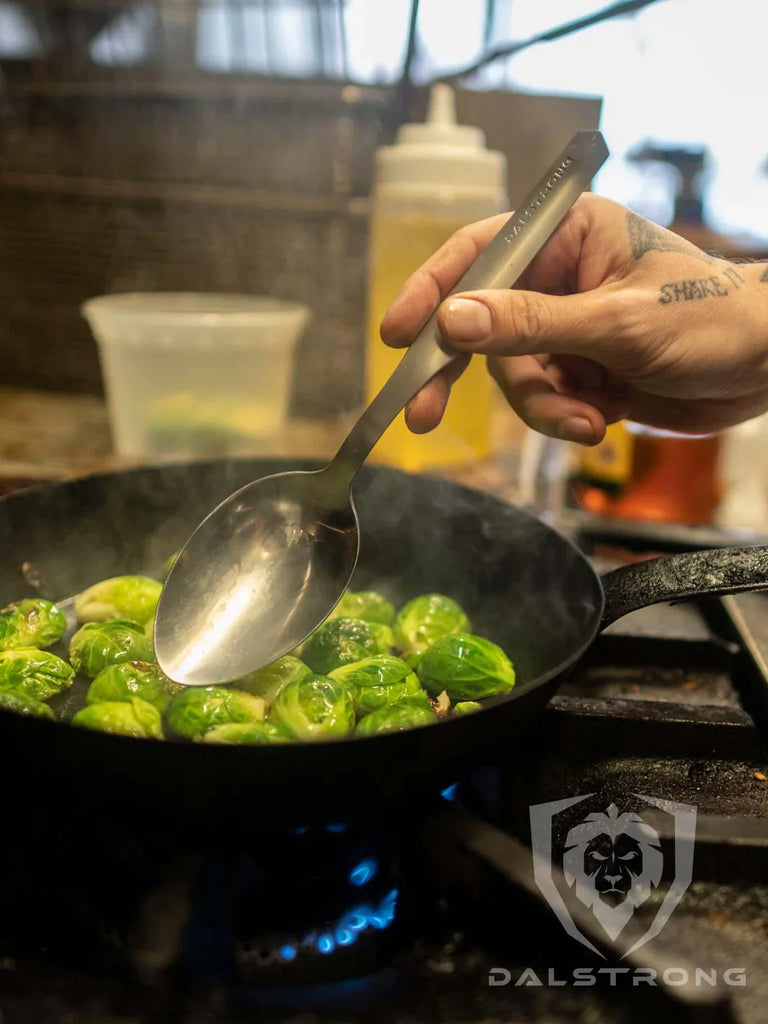 Silver Stainless Steel 20-Piece Flatware Cutlery Set
Silver Stainless Steel 20-Piece Flatware Cutlery Set
Ever paused mid-meal, a fork or spoon in hand, and pondered the journey that utensil took to make it to your table? No? Just me? I'm being a weirdo? Well, let's talk about spoons and forks anyway.
1. History Of Spoons And Forks
 Silver Stainless Steel20-Piece Flatware Cutlery Set
Silver Stainless Steel20-Piece Flatware Cutlery Set
Did you know that the fork was once considered scandalous? When forks first graced the European dining tables, they stirred up more controversy than a chef experimenting with fusion cuisine. Seen initially as a frivolous affront to traditional eating methods—why forsake fingers when they were divinely provided? – the fork's journey from near-pariah status to tabletop staple was fraught with societal skepticism. Initially brought over from the Middle East, its early adoption by the Italian nobility, notably through figures like Catherine de Medici, slowly softened its image, transforming it from a devilish prong to a symbol of refinement in places like the United Kingdom.
Meanwhile, spoons were enjoying a far smoother ride through history, tracing their lineage back to the Stone Age. Their form varied from shells and wood to the more elaborate silver and gold versions, reflecting not only their utility but also their role in ceremonies and as markers of wealth. By the Middle Ages, personal spoons were so cherished that individuals often carried their own, indicating their intimate and indispensable role in daily life.
By the 18th century, forks had finally pronged their way into the heart of European dining, evolving from two to four tines and becoming essential companions to the spoon. This period marked a significant shift in dining etiquette, with the fork's acceptance signaling a move towards more sophisticated table manners and the refinement of mealtime rituals. Today, forks and spoons, part of the larger family of flatware sets, are not just tools but relics of culinary evolution, reflecting centuries of social, cultural, and technological changes.
2. What Is The Right Way To Use Forks And Spoons
 Silver Stainless Steel 20-Piece Flatware Cutlery Set
Silver Stainless Steel 20-Piece Flatware Cutlery Set
Navigating the etiquette of forks and spoons at the dining table is akin to performing a well-choreographed dance, where each utensil has its moment to shine. The right way to use these tools is not just about avoiding social faux pas; it's an art form steeped in tradition and practicality. For instance, the American style of dining often involves the "zig-zag" method, where the fork and knife are used in tandem to cut and then the fork is switched to the right hand for eating.
Contrast this with the Continental style, where the fork remains in the left hand, tines down, and the knife in the right, used together in a seamless ballet to enjoy a meal. Each method has its proponents, and both are accepted as proper table manners. Remember, the soup spoon, with its rounder bowl, is reserved for your broths and soups, while the dessert spoon and fork, usually smaller than their dinner counterparts, await their curtain call at the end of a meal.
But what about other utensils?
The serving fork, larger and often used in pair with a serving spoon, is designed for plating food from communal dishes, not for individual use. The dinner fork, typically larger than the salad fork, is your go-to for the main course. And let's not overlook the importance of the knife in this ensemble; from the dinner knife to the more specialized steak knife, each plays a critical role in ensuring a pleasant dining experience.
Properly setting these utensils around the plate, adhering to a sensible table setting, enhances both the aesthetics and the functionality of the dining experience. So, whether you're meticulously arranging a flatware set for a formal dinner or simply setting the table for a casual meal, knowing the role and right way to use each fork, spoon, and knife not only elevates the meal but also pays homage to a tradition of dining that spans centuries.
Read about 8 clever ways to store your silverware, here.
3. How To Choose An Exceptional Flatware
 Dalstrong Professional Chef Tasting & Plating Spoon
Dalstrong Professional Chef Tasting & Plating Spoon
Selecting the ideal flatware set is an art form that combines aesthetics with practicality, akin to outfitting your dining table in its very best. The quest for the perfect set—be it opulent silverware sets for gala dinners or robust cutlery sets for daily use—requires careful consideration of several factors to ensure your table is not only set but set apart.
Material matters
The choice of material is pivotal. Silver flatware sets add a touch of traditional elegance and can turn any meal into an event. Stainless steel, on the other hand, offers unmatched durability and a modern appeal, making it ideal for everyday use as well as special occasions. For those leaning towards sustainability, compostable cutlery provides an eco-friendly alternative without compromising on style.
Each material brings its unique flavor to the table, influencing not only the appearance but also the care and longevity of your flatware. And dishwasher safe cutlery is always a plus. Maybe avoid gold plastic, though.
Feel and function
The ergonomics of a fork knife spoon set is crucial. It should feel like an extension of your hand, comfortable to hold, and balanced in weight. The right set enhances the dining experience, making every bite a little more enjoyable. This is where the quality of your cutlery sets truly comes to the fore.
Design and durability
Aesthetics play a significant role in the selection process. Flatware is not just about utility but also about expressing personal style. From sleek, modern designs with clean lines to more ornate patterns that echo historical elegance, there’s a range to suit every taste. Custom printed options offer a unique touch, allowing for personalization that can add a special layer of meaning to your set. Moreover, durability is extremely important. Your chosen set should withstand the test of time and frequent use, resisting wear and tarnish. Opt for designs that promise longevity, so your investment continues to add sparkle to your table for years to come.
Lastly, consider the convenience of international shipping, especially when your perfect flatware set isn't available locally. This opens up a world of options, ensuring you don’t have to compromise on your vision for the ideal table setting. Whether you're assembling the perfect ensemble for a formal dinner party or curating a collection that elevates everyday meals, selecting the right flatware involves balancing material, function, design, and durability to find a set that reflects your personal style and meets your dining needs.
4. Must-Have Dalstrong Flatware
1. Silver Stainless Steel 20-Piece Flatware Cutlery Set
This 20-piece stainless steel set isn't just about eating; it's about adding a dash of style to every bite you take. Imagine hosting a dinner and everyone's buzzing not just about the food but also about how snazzy your cutlery is.
PROS:
- This set's made of top-notch 18/10 stainless steel, which basically means it's tough as nails. You can use and abuse it, and it'll still look shiny and new.
- Feeling the weight of these pieces in your hand, you'll know you're holding onto something quality. They're sturdy but shaped in a way that they feel just right, like they were made for your hand.
- The design's got this sleek, peaked angle handle thing going on that makes your regular old cutlery look kinda...well, old.
- Opening the box feels like Christmas came early—it's that nicely packaged. Plus, it's a breeze to keep them looking spotless.
CONS:
- They've got a bit of heft to them, which is actually a sign of quality, but just a heads-up if you're used to featherlight forks and knives.
- If your table's all about that color and wild designs, these might seem a bit too classic for your taste. But hey, classic is timeless, right?
2. Black Stainless Steel 20-Piece Flatware Cutlery Set
The Black Stainless Steel 20-Piece Flatware Cutlery Set, a sleek and modern addition to any dining experience. Crafted with a contemporary twist on the traditional stainless steel, this set adds a touch of sophistication to your table setting.
PROS:
- The black stainless steel finish exudes a sense of elegance and modernity, elevating the overall look of your table setting.
- Whether you're hosting a formal dinner party or enjoying a casual meal with family, the versatile design of this cutlery set complements various dining occasions.
- Made from high-quality stainless steel, this cutlery set is built to withstand daily use and is resistant to rust, corrosion, and tarnishing, ensuring long-lasting durability.
- Cleaning is a breeze with this set, as the smooth surface of stainless steel makes it easy to wipe clean, and it is dishwasher safe for added convenience.
- The ergonomic design of the utensils provides a comfortable grip, allowing for a pleasant dining experience without causing strain on the hands.
CONS:
- While the black stainless steel finish adds a contemporary flair to your table setting, it may not appeal to those who prefer more traditional silver-toned cutlery.
3. Dalstrong Professional Chef Tasting & Plating Spoon
The Dalstrong Professional Chef Tasting & Plating Spoon, a precision tool designed to elevate your culinary creations to new heights. Crafted with the expertise of professional chefs in mind, this spoon is an essential addition to any kitchen arsenal.
PROS:
- Meticulously crafted from high-quality materials, ensuring durability and longevity even under rigorous kitchen conditions.
- This spoon is designed for a myriad of culinary tasks, from delicate plating and precise portioning to effortless tasting and sauce drizzling, making it an indispensable tool.
- Featuring a finely tapered edge and a perfectly balanced handle, this spoon allows for precise control and maneuverability, enabling chefs to create intricate designs and flawless presentations with ease.
- The ergonomic handle is thoughtfully designed for maximum comfort and grip, reducing fatigue during prolonged use and ensuring a seamless cooking experience.
- The sleek and seamless design of the spoon makes it easy to clean by hand or in the dishwasher, saving you time and effort on maintenance.
CONS:
- While incredibly versatile, this spoon is primarily designed for tasting and plating purposes, meaning it may not replace the need for other specialized utensils in your kitchen arsenal.
5. Frequently Asked Questions
What are spoons and forks called?
Spoons and forks are collectively known as flatware or cutlery, the shining stars of any dining table, playing pivotal roles in the grand performance of a meal.
What is the use of a spoon and fork?
Beyond their primary function of helping us eat, spoons and forks are cultural artifacts, telling tales of etiquette, innovation, and culinary history. From the humble soup spoon to the multifaceted fork set, each has its own part to play.
What's the difference between a fork and a spoon?
The spoon is your go-to for anything liquid or semi-liquid, thanks to its concave shape, while the fork, with its prongs (or tines), is perfect for picking up solid food. Together, they're the dynamic duo of the dining world.
What is a spoon that is a fork?
The spork is a modern marvel of modern utensil innovation! It combines the scooping ability of a spoon with the poking prowess of a fork. Perfect for your ramen spoon needs or tackling a shopping bag full of take-out with minimal utensil fuss.














































































































































































































































































































































































